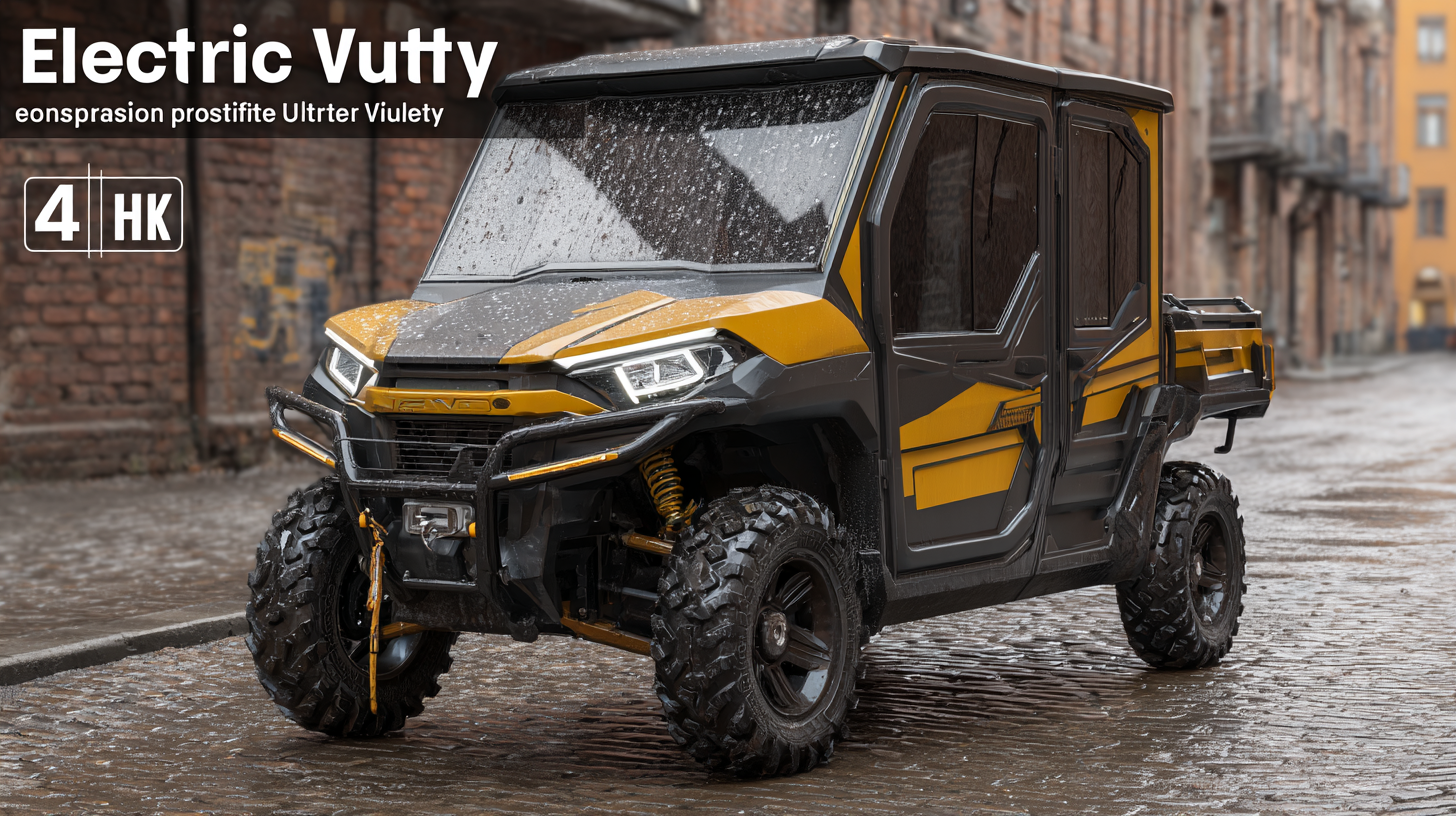
Solutions for Efficient Transportation with the Best Electric Utility Vehicle
As urbanization continues to accelerate, the demand for efficient transportation solutions has never been more pressing, particularly in the realm of logistics and utility services. According to a recent report by McKinsey & Company, electric utility vehicles (EUVs) are projected to represent a significant portion of the market, with global sales expected to reach 2.3 million units by 2030. This shift towards electric mobility not only promises to reduce greenhouse gas emissions but also offers substantial cost savings on fuel and maintenance for operators.

The Rise of Electric Utility Vehicles: Transforming Urban Transportation
The rise of electric utility vehicles (EUVs) is transforming urban transportation, offering innovative solutions to the growing challenges of congested cities and environmental concerns. With increasing urban populations, traditional combustion engine vehicles contribute significantly to air pollution and traffic jams. Electric utility vehicles, designed specifically for efficiency and sustainability, are emerging as a pivotal alternative, making urban mobility cleaner and more efficient.
EUVs are not only environmentally friendly but also versatile, catering to various urban needs from deliveries to public transportation. Their low operating costs and reduced maintenance requirements, compared to gasoline-powered vehicles, enable businesses and municipalities to optimize their transportation strategies.
Furthermore, with advancements in battery technology, electric utility vehicles are becoming more accessible, providing longer ranges and faster recharging times, thus making them a practical choice for urban settings. As cities evolve, embracing electric utility vehicles will be instrumental in achieving smarter, greener, and more efficient transportation solutions.
Key Benefits of Electric Utility Vehicles in Reducing Carbon Emissions
Electric utility vehicles (EUVs) are rapidly gaining traction in the transportation sector due to their significant role in reducing carbon emissions. According to the International Energy Agency (IEA), transitioning to electric vehicles could potentially cut global CO2 emissions by up to 1.5 gigatons annually by 2030. The exceptional energy efficiency of EUVs, which operate at about 75% efficiency compared to gasoline vehicles at approximately 20%, plays a vital part in this transformation. For companies focused on sustainability, adopting EUVs not only enhances operational efficiency but also aligns with environmental goals.
In addition to reducing greenhouse gases, electric utility vehicles contribute to improved urban air quality. The World Health Organization (WHO) reports that air pollution is responsible for approximately 7 million premature deaths each year, underscoring the importance of cleaner transportation alternatives. By replacing traditional vehicles with electric models, cities can significantly lower harmful emissions, supporting healthier communities. A study from the U.S. Department of Energy found that if all medium-duty trucks were converted to electric, the reduction in emissions could be as much as 2 billion tons over their lifetime. This shift not only mitigates climate change impacts but also leads to a more sustainable and economically viable future for transportation.
Solutions for Efficient Transportation with the Best Electric Utility Vehicle - Key Benefits of Electric Utility Vehicles in Reducing Carbon Emissions
| Dimension | Electric Utility Vehicle A | Electric Utility Vehicle B | Electric Utility Vehicle C |
|---|---|---|---|
| Range (miles) | 120 | 150 | 100 |
| Cargo Capacity (lbs) | 2000 | 2500 | 1800 |
| Charging Time (hrs) | 5 | 4 | 6 |
| Emissions Reduction (%) | 70 | 80 | 60 |
| Annual Fuel Cost Savings ($) | 1500 | 2000 | 1200 |
Analyzing the Total Cost of Ownership for Electric vs. Gas Utility Vehicles
The total cost of ownership (TCO) is a critical factor when comparing electric and gas utility vehicles. Recent reports indicate that the market for electric utility vehicles, including golf carts, is expected to grow significantly due to rising demand from aging populations and expanding retirement communities. From 2025 to 2034, the U.S. golf cart market alone is projected to reach a valuation of $1.7 billion, with a compound annual growth rate of 6.4%. This growth is driven by the increasing adoption of electric vehicles as consumers and organizations prioritize sustainability and cost efficiency.
When analyzing TCO, electric vehicles often present a more favorable option compared to their gas counterparts. Electric utility vehicles typically have lower fuel costs, reduced maintenance expenses, and longer life spans. Although the initial purchase price may be higher for electric models, incentives and the decreasing costs of battery technology are making them increasingly competitive in the long term. Studies suggest that over time, electric vehicles can offer significant savings, which should be a key consideration for anyone evaluating their options in utility transport.
Comparative Total Cost of Ownership: Electric vs. Gas Utility Vehicles
Top Features to Look for When Choosing the Best Electric Utility Vehicle
When selecting the best electric utility vehicle (e-UTV) for efficient transportation, several key features should be prioritized. First, consider the vehicle’s range and battery capacity. A robust battery that offers an extended driving range is essential for completing tasks without frequent recharging. Look for models that boast fast-charging capabilities to minimize downtime, allowing for smoother operations throughout the day.
Another critical feature is cargo capacity. An ideal electric utility vehicle should provide ample space for tools, equipment, and other essentials. Additionally, assess the vehicle's versatility. Features such as adjustable seating configurations and towing capabilities can enhance its practicality for various applications, be it commercial or recreational. Moreover, focus on the vehicle’s off-road capabilities if intended for rugged terrains, as this will ensure reliability in diverse working environments, from construction sites to farms.

Case Studies: Successful Implementation of Electric Utility Fleets in Major Cities
Electric utility vehicles (EUVs) are rapidly transforming urban transportation, with several major cities leading the way in implementing electric utility fleets. These case studies serve as valuable examples of how municipalities can achieve sustainability while improving operational efficiency. For instance, San Francisco has successfully integrated electric trucks for waste management, reducing carbon emissions significantly while maintaining service reliability. Similarly, cities like Los Angeles and Seattle have adopted electric buses for public transportation, showcasing not only environmental benefits but also cost savings in fuel and maintenance.
**Tip 1:** When planning for an electric utility fleet, consider starting with a pilot program. This approach allows cities to evaluate performance, gather data, and make informed decisions before a full-scale implementation.
Another noteworthy example is London, which has introduced electric vans for logistics and delivery services within the city. This initiative has contributed to cleaner air and less noise pollution, demonstrating the potential of EUVs to enhance urban living.
**Tip 2:** Partnering with local utility companies can facilitate smoother transitions to electric fleets. These partnerships can provide essential insights into charging infrastructure and support grant applications for funding.
As cities worldwide explore innovative transportation solutions, the successful implementation of electric utility fleets stands as a powerful testament to the positive impact of technology on urban infrastructure.
